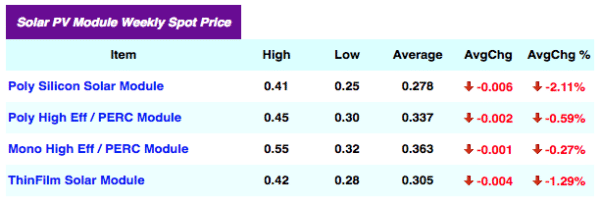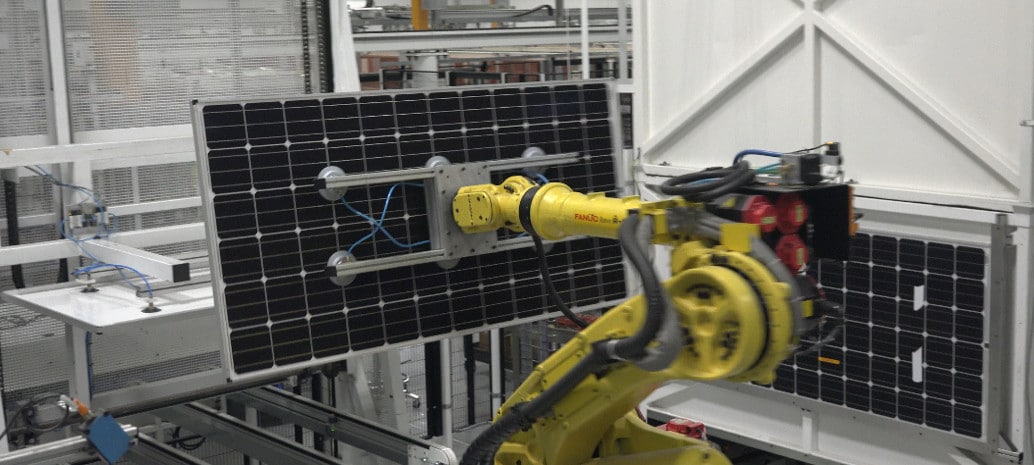Well, that didn’t take long.
Only days after the Chinese government announced a substantial withdrawal of support for solar PV on May 31, Bloomberg New Energy Finance (BNEF) responded with a report forecasting that global PV module prices would fall 34% over the course of 2018, estimating that monocrystalline silicon modules would cost only $0.24 per watt by the end of the year.
The note also predicted “market panic” in the short term. Only a few weeks later both dynamics to appear to be at play, according to data by PV Insights and EnergyTrend.
As of June 20, PVInsights estimated that average PV module prices had fallen to $0.278 per watt for standard multicrystalline modules, with multi-PERC modules coming in at an average of $0.337 per watt, and mono-PERC modules at $0.363 per watt.

Taken from the PVInsights site
These numbers represent declines from 0.3% to 2.1% over the course of the last week, with the greatest fall for standard multicrystalline products.
PVInsights is not the only company reporting this information. EnergyTrend is also reporting average prices from $0.295 per watt to $0.367 per watt as of June 20, depending on the type of module. However EnergyTrend is seeing these numbers as the result of a much steeper weekly fall, describing price falls of up to 12.5%.
Again the steepest declines were for standard multicrystalline products.

Taken from the EnergyTrend site.
Both of these appear to be global estimates, however in Europe Martin Schachinger of pvXchange is also reporting collapsed prices. “After a lack of cheap modules due to artificially induced bottlenecks caused by the market regulations in the USA and in Europe and the resulting stagnating prices, we now look forward to a module glut which inevitably causes prices to tumble,” notes Schachinger in a post on the pvXchange site (in German).
5-10% fall in U.S. module prices
Current U.S. prices are higher, as global module imports are affected both by Section 201 tariffs and Chinese product is subject to anti-dumping and countervailing duties imposed on solar cells and modules from Taiwan and China in 2012 and 2014.
However, prices appear to be falling in the United States as well. Leni John, the head of procurement at developer Strata Solar, estimates that U.S. module prices have fallen 5-10% over the last month, with greater declines for multicrystalline product than for monocrystalline.
This is in line with BNEF’s previous forecast, as the company noted the liquid nature of global module supply and ample capacity in Southeast Asia, Korea and Taiwan to serve the U.S. market.
However, John notes that module price declines have not fully offset the impact of Section 201 tariffs, which he says is still affecting the market. “By no means are we back to where we were prior to the tariff being implemented,” John told pv magazine.
Additionally, as has been the case in the past the anticipation of future price declines may lead some developers and EPCs to wait on purchases and thus delay projects.
This content is protected by copyright and may not be reused. If you want to cooperate with us and would like to reuse some of our content, please contact: editors@pv-magazine.com.









By submitting this form you agree to pv magazine using your data for the purposes of publishing your comment.
Your personal data will only be disclosed or otherwise transmitted to third parties for the purposes of spam filtering or if this is necessary for technical maintenance of the website. Any other transfer to third parties will not take place unless this is justified on the basis of applicable data protection regulations or if pv magazine is legally obliged to do so.
You may revoke this consent at any time with effect for the future, in which case your personal data will be deleted immediately. Otherwise, your data will be deleted if pv magazine has processed your request or the purpose of data storage is fulfilled.
Further information on data privacy can be found in our Data Protection Policy.